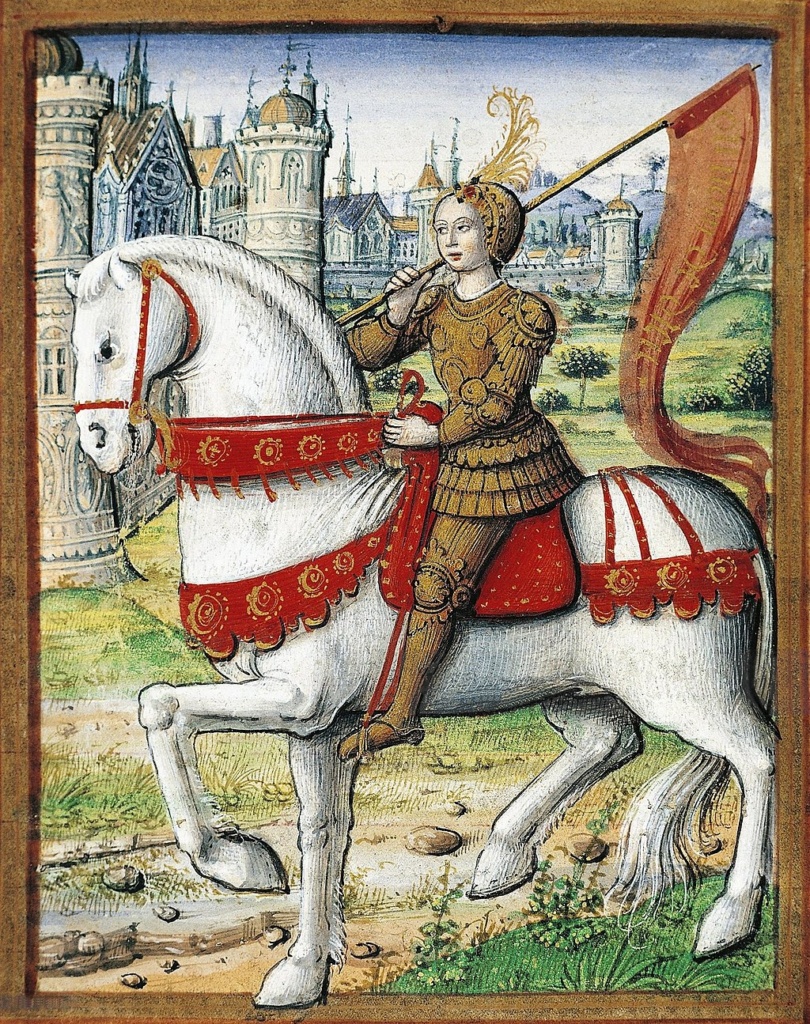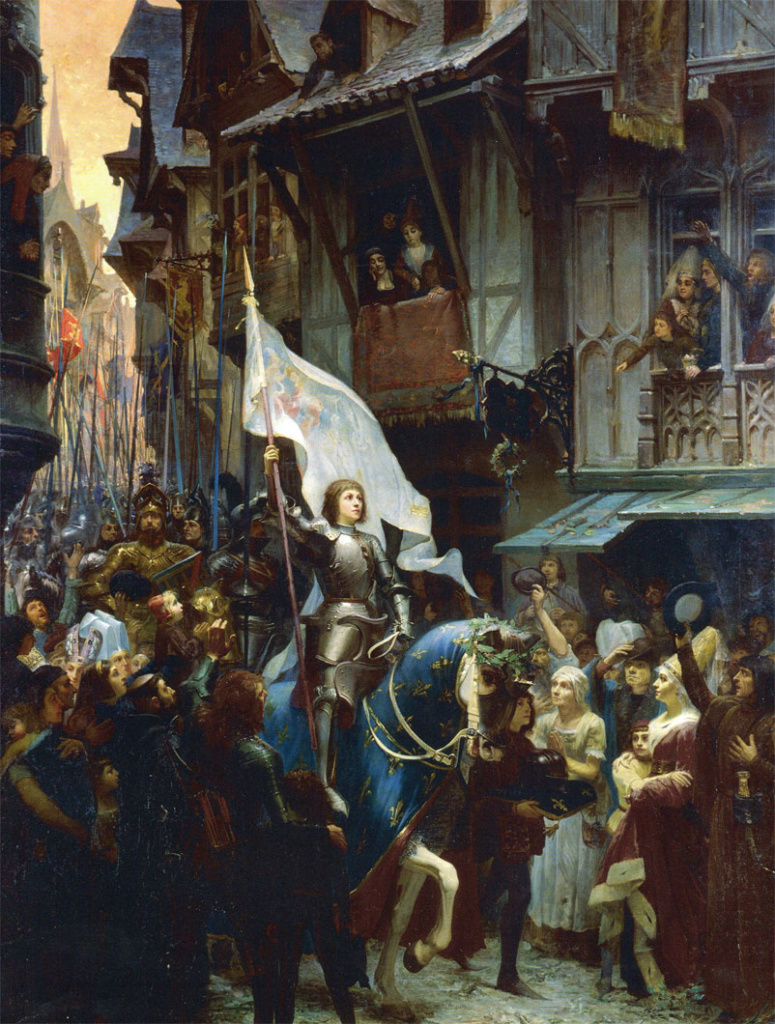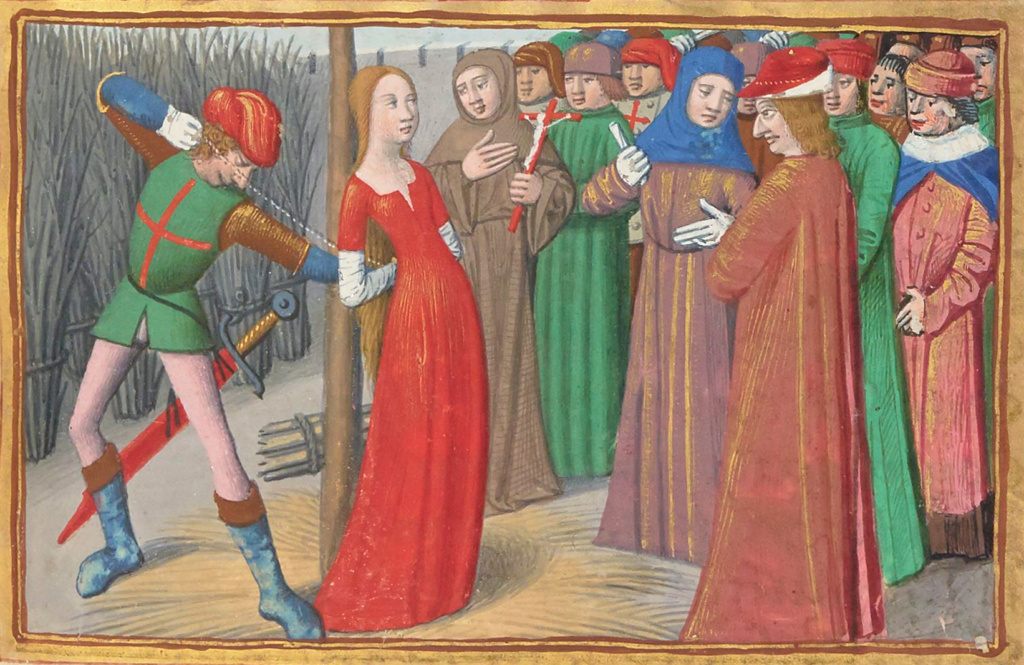Compiled by ArtiZen Editor

Joan of Arc, 1412-1431, French’s first and most prominent female role model of ethics and true grit is a young military leader, honored as the Savior of France for her role in the siege of Orleans and her insistence on the coronation of Charles VII of France during the last stage of the Hundred Years War between kingdoms of England and France. Claiming to be acting under divine guidance, she became a national hero who transcended gender roles but ending up being burned at the stake on the cross in defiance of false convictions from the corrupted religious and government authority.
Joan was born in a poor peasant family in the village of Dormremy lay upon the confines of territory which recognize the suzerainty of the Duke of Burgundy, who entered in alliance with the English while Deomremy had always remained loyal to Charles. Joan never learned to read or write but she remain a singularly pious child, grave beyond her years, often pray in the church.
It’s said that at her age of 13, Joan became conscious of her own supernatural character and gradually discern some divine voices from the Angels St. Michael, St. Margaret and St. Catherine, it was these voices which created the state of patriotic exaltation. In may 1428, she no longer doubted that she was bidden to go to the help of the king. She first presented herself to Robert Baudricourt, the commander for Charles VII in the neighboring town of Vaucouleurs. But Robert was a rude and dissolute soldier, treated her with scant respect by telling her cousin who accompanied her: “take her home to her father and give her a good whipping”.

Meanwhile the millitary situation of King Charles and his supporters was growing more desperate. Orleans was invested October, 1428, on the call of god, she left home and again visited Vaucouleurs. Robert Baudricourt was still skeptical, but as she stayed on in the town, her persistence made an impression on him. In Feb she foreseen a great defeat befallen the French arms outside Orleans, and the statement was confirmed days later which made her cause gained ground. Finally she made her way to seek the King with a slender escort of three men-at-arms, she being attired in make costume at her own request, undoubtedly as a protection to her modesty in the rough life of the camp. She always slept fully dressed, and all those who were intimate with her declared that there was something about her which repressed every unseemly thought in her regard.
Two days later, Joan was admitted into the presence of Charles VII. To test her, the king had disguised himself but she at once saluted him without hesitation amidst a group of attendants. However from the beginning, the court party opposed her as a crazy visionary, but a secret sign was communicated to her by her voices, which she made known to Charles led the king somewhat half-hearted to believe in her mission. Charles had always doubt his legitimacy of his birth, and which Joan had been supernaturally authorized to set at rest.
Still, before Joan could be employed in military operations she was sent to be examined by a numerous committee of learned bishops and doctors. The examination of the most searching and formal character. But her ardent faith, simplicity, and honesty made a favorable impression. The theologians found nothing heretical in her claims to supernatural guidance, they thought that she might be safely employed and further tested.
Returning to Chinon, Joan found an ancient sword buried behind the altar in the chapel of Ste-Catherine-de-Fierbois. The sword bear the words Jesus, Maria with a picture of God the Father and kneeling angels presenting a fleur-de-lis.
Before any of the imminent battle events referred to received their fulfillment. The maid said that she would save Orleans and would compel the English to raise the siege, that she herself in a battle before Orleans would be wounded by a shaft but would not die of it. And the king in the course of the coming summer would be crowned at Reims.

Before entering upon her campaign, Joan summoned the King of England to withdraw troops from French soil. The English commanders were furious at the audacity of the demand but Joan entered Orleans bu a rapid movement. Her presence there at once worked wonders. By 8 May the English forts which encircled the city had all been captured, and the siege raised, though on the 7th Joan was wounded in the breast by an arrow. So far as Joan went, she wished to follow up these successes with all speed, partly from a sound warlike instinct. But the king and archbishop of Reims were slow to move, at Joan’s earnest entreaty, a short campaign was begun upon the Loire, which after a series of successes, ended on 18 June with English reinforcement were completely routed. The way to Reims was now practically open but Joan had the greatest difficulty in persuading the commanders not to retire until they capture the town Troyes, and reached Reims, where on Sunday 17, July Charles VII was solemnly crowned, the maid standing by with her standard, for “as it had shared in the toil, it was just that it should share in the victory”.
The principle aim of Joan’s mission was thus attained, and some authorities assert that it was now her wish to return home, but due to the complex and leery diplomatic bait thrown out by the Duke of Burgundy, Joan was constantly oppressed by the apathy of the king and his advisers. The inactivity of the following winter, mostly spent amid the worldliness and the jealousy of the court, must have been a miserable experience for Joan. In May, Joan was back to the field to defend the town of Compiegne against Burgundian attack. In the evening she resolved to attempt a sortie, but little troop of five hundred encountered a much superior force. By some mistake or panic of the commander in Compiegne, the drawbridge was raised while still many who had made the sortie remained outside, Joan amongst the number. She was pulled down from her horse and captured by the enemy troop.

No words can adequately describe the disgraceful in gratitude and apathy of Charles and his advisors in leaving Joan to her fate. And the English feared their prisoner with a superstitious terror, were determined at all costs to take her life. They could not put her to death for having beaten them, but they could get her sentenced as a witch and a heretic. So she was put on trail by an ecclesiastical court and detained in a secular prison.
As regards the official record of the trial, the answers to inquisition questions are in every way favorable to Joan. Her simplicity, piety, and good sense appear at every turn, despite the attempts of the judges to confuse her. Her attitude was always fearless and in May she boldly announced that “within in seven years” space the English should have to forfeit a bigger prize than Orleans, which was testified as the fact that Paris was lost to Henry VI in 1437.

The examinations terminated with 12 propositions were summarized by a large majority of the 22 judges who took part in the deliberations declared that Joan’s visions and voices to be false and diabolical. Months later, the end came when a court of 37 judges decided unanimously that the maid must be treated as a relapsed heretic, and this sentence was actually carried out the next day amid circumstances of intense pathos. She asked for a cross which she had embraced it, was held up before her while she called continuously upon the name of Jesus.
Twenty-four years later a revision of her trial was reopened at Paris with the consent of the Holy See. Now an appellate court constitutes by the pope, after long inquiry and examinations of witnesses, reversed and annulled the sentence pronounced by a local tribunal under Cauchon’s presidency. At last the cause of her beatification was introduced upon occasion of an appeal addressed to the Holy See. In 1909, a mass and office of St.Joan, taken from the “Commune Virginum” have been approved to use to commemorate Joan of Arc.

Reference:




